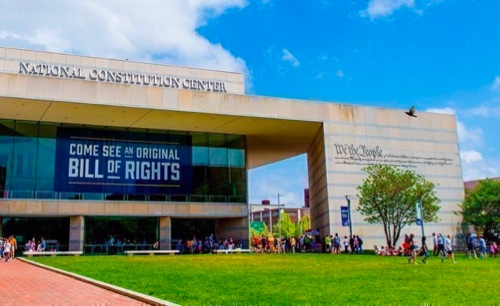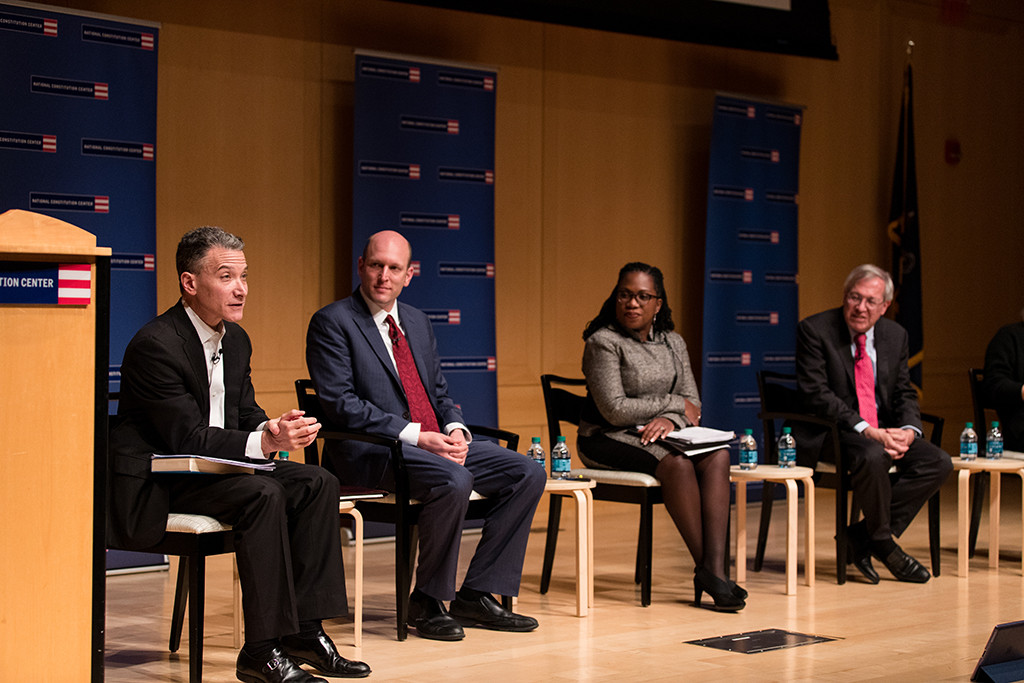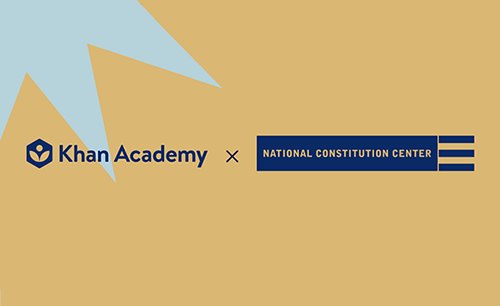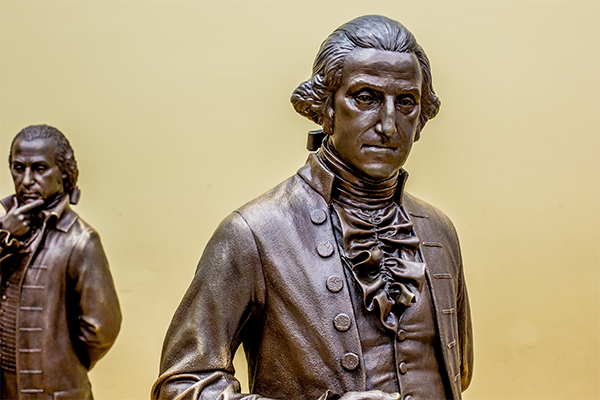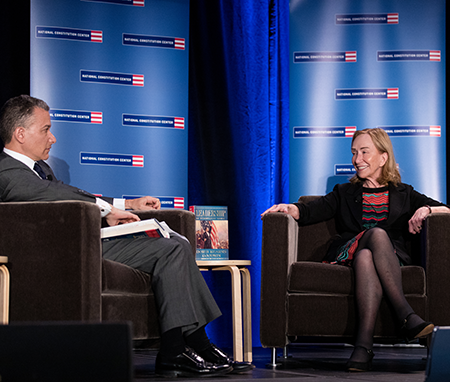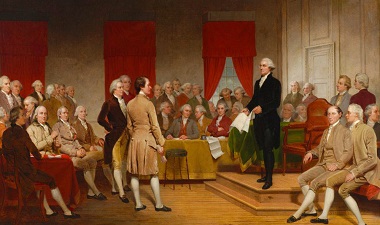On June 27, 2025, the Supreme Court delivered its final decisions of the 2024–25 term. In this episode, Steve Vladeck of the Georgetown University Law Center and Sarah Isgur of SCOTUSblog join to discuss the significant cases from this Supreme Court term.
Please follow We the People and Live at the National Constitution Center on Apple Podcasts, Spotify, or your favorite podcast app.
Today’s episode was produced by Griffin Richie, Samson Mostashari, and Bill Pollock. It was engineered by Bill Pollock. Research was provided by Griffin Richie, Samson Mostashari,Gyuha Lee, Cooper Smith, Trey Sullivan, and Tristan Worsham.
Participants
Steve Vladeck is a professor of law at the Georgetown University Law Center. He is the author of the New York Times-bestselling book, “The Shadow Docket: How the Supreme Court Uses Stealth Rulings to Amass Power and Undermine the Republic,” and is also the editor and author of “One First,” a popular weekly newsletter about the Supreme Court.
Sarah Isgur is the editor of SCOTUSblog and an ABC News legal analyst. She hosts the legal podcast Advisory Opinions with David French.
Jeffrey Rosen is the president and CEO of the National Constitution Center, a nonpartisan nonprofit organization devoted to educating the public about the U.S. Constitution. Rosen is also professor of law at The George Washington University Law School and a contributing editor of The Atlantic.
Additional Resources
- Trump v. CASA, Inc. (2025)
- Mahmoud v. Taylor (2025)
- DHS v. DVD (2025)
- Steve Vladeck, “163: A New Kind of Judicial Supremacy,” One First (June 30, 2025)
- Advisory Opinions podcast
Steve Vladeck argues that Justice Kavanaugh’s concurrence in Trump v. CASA signals the Court’s shift towards emphasizing emergency rulings, a trend he described as “a new kind of judicial supremacy.”
Steve Vladeck: Sure. I mean, I think one of the things that really separates this most recent term from a lot of the ones that we're used to is just how much of the bigger and more significant rulings came on emergency applications. And Justice Kavanaugh's concurrence came on an emergency application. It came with regard to the Trump administration's request to put back into effect most of the president's controversial and, to my mind, clearly unlawful executive order on limiting birthright citizenship. So what Justice Kavanaugh said was, this is something we should be doing, that whenever a president hands down a controversial new policy, there's always gonna be a debate as to what the nationally uniform interim rule ought to be while the lawsuits challenging that policy make their way to the Supreme Court, should there be a uniform national rule, and if so, Jeff, who should hand it down? And the Kavanaugh concurrence is basically saying like, "Yes, more often than not, we're gonna want a national uniform interim rule, and more often than not, that rule should come from us, the Supreme Court, not lower courts."
And so Jeff, where I take that to be saying is Justice Kavanaugh both defending much of what the Supreme Court has done so far this term, it's granted 14 different emergency applications from the Trump administration, but also I think, Jeff, a promise that they're gonna keep doing this, that more and more of the Supreme Court's work is gonna be defined by these late-breaking, quick-hitting, emergency applications about whether some of the more controversial actions President Trump is pursuing are gonna be allowed to go into effect or gonna remain on hold while the case is challenging them, work their way through the lower courts and ultimately to the Supreme Court. So it's Justice Kavanaugh roadmapping both the world that we've seen over the last five months and the world that I suspect we're now gonna see much more of over the next three and a half years.
Sarah Isgur considers Chief Justice’s Roberts’ institutional vision of the Supreme Court, comparing him to Chief Justice Marshall preserving the Court’s legitimacy amid political pressure.
Sarah Isgur: You have this original interview with him shortly after he becomes chief justice in his only second term on the court, and I go back to that and read it like it is biblical text, Jeff, because it really lays out the Chief's own metrics for success. He says he wants to emulate Chief Justice Marshall, the OG chief justice, if you will, though of course he was the fourth chief justice, but John Jay, I mean, please, my friend. You really failed there. And he's defining that as this institutionalism, unanimity, speaking in one voice. By any of those metrics, that has not been this Court. This Court has not been more unanimous than past Courts by any means. There have been more concurrences written per term, per opinion, than at any point in the court's history. So it's really a fractured court in that sense. But in 2005, when he became chief justice and was thinking lofty thoughts about Chief Justice Marshall, perhaps he didn't have in mind the chief justice's role vis-a-vis Thomas Jefferson and Marbury v. Madison and, of course, Andrew Jackson yet to come. But this idea of an executive trying to take on the judicial branch and the Supreme Court in particular and bend it to its will, politically manipulate it.
Thomas Jefferson, of course, impeaches or leads to the impeachment of Justice Chase on the court. His plan is to impeach Chief Justice Marshall next so that he can have a court that reflects his political views, not an independent judiciary. And Chief Justice Marshall really guides the court through the rockiest of waters where the Supreme Court, as we know it, would not exist. But for Chief Justice Marshall, he was considered incredibly charismatic and charming. Everyone liked him. You can think back to his time at Valley Forge. He's 19, 20 years old in that winter of 1777. He's sharing a cabin with James Monroe. He's the life of the party. Like, people are literally starving and dying of cold, and Chief Justice Marshall's like playing drinking games and telling them to quit complaining, that they're being whiners. Suck it up. He's the life of the party at Valley Forge.
So in that sense, I wonder whether we will look back and see John Roberts as quite the Marshall-esque figure in his role vis-a-vis President Biden, suggesting packing the court and having a Supreme Court Commission, looking at fundamentally changing the independence of the Supreme Court. And then, of course, Donald Trump as almost a Jacksonian figure, threatening to defy the Court as well, or ignore the Court. So a lot of credit to Chief Justice Roberts. Again, you can only judge in hindsight. We'll see how he does, but he certainly is wearing some of the hat of Chief Justice Marshall, just not the one he thought he would wear.
Full Transcript
View Transcript (PDF)
This transcript may not be in its final form, accuracy may vary, and it may be updated or revised in the future.
Stay Connected and Learn More
- Questions or comments about the show? Email us at [email protected]
- Continue the conversation by following us on social media @ConstitutionCtr
- Sign up to receive Constitution Weekly, our email roundup of constitutional news and debate
- Follow, rate, and review wherever you listen
- Join us for an upcoming live program or watch recordings on YouTube
- Support our important work
